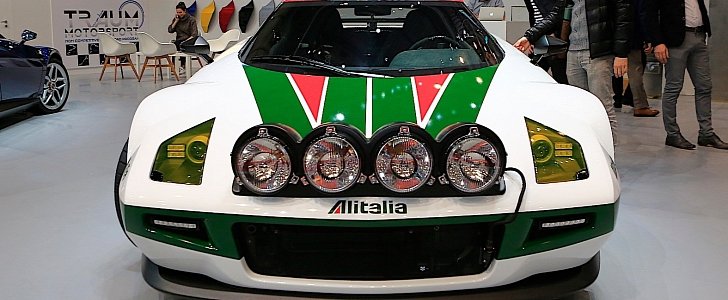Last year, fans of the Lancia Stratos welcomed the news of the nameplate being partially - and finally - revived by Manifattura Automobili Torino (MAT) and New Stratos. We even got a chance to see the first prototype at the 2018 Geneva Motor Show.
This year MAT unveiled two production Stratos cars at the same event. They are the first two of a total of 25 that will ever be produced. Destined to arrive in the hands of unnamed customers’ in Germany and the U.S., the two are for the moment taking their time under the spotlight.
The New Stratos is in fact a conversion of the Ferrari F430, but MAT likes to say it is “an independent sports car that integrates several components from the Fiat Group’s production vehicles.” In reality, anyone with an F430 or 430 Scuderia laying around could have it turned into a New Stratos.
According to MAT sales manager Riccardo Garella, speaking for Motoring, turning a Ferrari F430 into a Stratos takes about three months. Customers can buy the full car from MAT, or have their own F430 converted for a price of 550,000 EUR ($617,000).
The New Stratos shown in Geneva uses the 4.3-liter V8 engine taken from the same Prancing Horse machine, only that it develops 540 hp and a maximum torque of 519 Nm at 3,750 rpm.. The engine can be paired to either a manual or a sequential transmission.
With a racing legacy to live up to, the MAT New Stratos has an acceleration time of 3.3 seconds and a limited top speed of 274 kph (170 mph).
Being meant for high-speed driving, the New Stratos comes with an FIA-compliant roll cage welded into the shortened aluminum chassis. That, combined with the addition of an air conditioning unit, addd enough pounds to the car, hence the need to use lightweight materials all around.
The New Stratos is in fact a conversion of the Ferrari F430, but MAT likes to say it is “an independent sports car that integrates several components from the Fiat Group’s production vehicles.” In reality, anyone with an F430 or 430 Scuderia laying around could have it turned into a New Stratos.
According to MAT sales manager Riccardo Garella, speaking for Motoring, turning a Ferrari F430 into a Stratos takes about three months. Customers can buy the full car from MAT, or have their own F430 converted for a price of 550,000 EUR ($617,000).
The New Stratos shown in Geneva uses the 4.3-liter V8 engine taken from the same Prancing Horse machine, only that it develops 540 hp and a maximum torque of 519 Nm at 3,750 rpm.. The engine can be paired to either a manual or a sequential transmission.
With a racing legacy to live up to, the MAT New Stratos has an acceleration time of 3.3 seconds and a limited top speed of 274 kph (170 mph).
Being meant for high-speed driving, the New Stratos comes with an FIA-compliant roll cage welded into the shortened aluminum chassis. That, combined with the addition of an air conditioning unit, addd enough pounds to the car, hence the need to use lightweight materials all around.

























